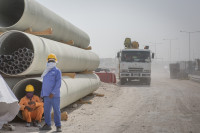Opinion
Puzzling energy budget
Sadly, the only energy sources the government cares about are hydropower and petroleum
Bibek Raj Kandel
The Rs1.29 trillion budget for the next fiscal year 2017-18 proposed earlier this week by Krishna Bahadur Mahara, former deputy prime minister and finance minister in the Prachanda administration, contained a few puzzles, like the proposed energy spending plan of Rs62.47 billion. While a 24 percent increment in energy spending compared to last year is a welcome move, there are no prominent elements in the government’s annual financial plan for energy enthusiasts to be elated about, except for some common items and commitments carried over from previous budgets.
No rational details
Let’s begin with the headline numbers. The budget says 17,000 MW will be generated in the next seven years. That’s good news. But a closer inspection of this tall target does not give us much context. This is 7,000 MW more than the target of 10,000 MW the government had planned to implement in line with National Energy Crisis Reduction and Development Decade 2016-26, an energy crisis action plan it unveiled last year. Oddly, the target has gone up, but the time span to achieve this higher target has been shortened by three years with no rational details on what scenario actually compelled this new escalation.
According to the electricity projection plan released by the Prachanda government last January, an installed capacity of 9,987 MW will be required to achieve 7.2 percent growth, and an installed capacity of 10,903 MW will be required to achieve 9.2 percent growth by 2025. It is important not to forget that these forecasts were made for highly ambitious scenarios envisaging 100 percent electric cooking in urban areas and electric cars and metros. So what kind of growth scenario are we actually talking by setting a target of 17,000 MW? Should we be excited about this new number or should we worry about too much prosperity so soon?
Nepal indeed needs a boost in energy supplies. And appropriately, the budget has emphasised a supply push by earmarking Rs10.17 billion for land compensation payments and other operation costs for the 1,200 MW Budhi Gandaki Hydropower Project. Likewise, it has set aside Rs500 million for the 456 MW Upper Tamakoshi Hydropower Project that is currently under construction, besides prioritising other reservoir-type hydro projects and promising timely disbursement of needed resources.
While this commitment to domestic generation is commendable, there is no clear proposal to arouse the interest of domestic and foreign investors in the budget. As a side note, we recently saw how the Nepal Electricity Authority (NEA), the sole power buyer in the country, is limiting the ability of domestic power producers to optimise their wet season generation, indicating a myopic vision of energy sector growth and economic loss in the long run.
If seen solely from the NEA’s point of view, this measure might look somewhat justifiable as it would prevent a potential scenario that obliges it to purchase surplus generation. However, for the broader national interest, forcing power producers to downsize their generation capacity not only has long-term negative consequences by not utilising potential generation space, it also doesn’t give the needed push to the NEA to proactively seek new demand streams.
Demand side initiatives
On the other hand, despite an overwhelming media buzz and broader public acceptance of the NEA’s demand side initiatives all these months, surprisingly, very little has been proposed for consumption efficiency in the new budget. While supply plays a dominant role, demand can also be tweaked. The aggressive demand side management that NEA Managing Director Kulman Ghising initiated led to a rapid and miraculous drop in power cuts that many analysts had never believed would be possible so soon.
Such a celebrated and successful move should actually have given a solid foundation to come up with systematic measures on demand side initiatives in the budget. Unfortunately, there is no spending portfolio to increase participation of utility consumers in demand side measures and consumption efficiency programmes. Other than LED solutions, demand side measures could have included tax waivers or financial incentives for the purchase of efficient irrigation tools, clean vehicles and electric cars. Likewise, strong regulations for efficient building standards and the like could have been imposed. The budget has missed the basic truth that every sector is linked to energy one way or the other.
The budget is equally notable for the knife it has put in small renewable energy technologies that have faced a 23 percent cut from the Rs6.1 billion spending plan in 2016-17. It is tragic but true; by putting these renewable energy targets under its environment protection expenditure plan, it’s a no-brainer to understand that none of the governments has recognised any energy form other than hydropower and petroleum as mainstream energy sources. The skinny targets of 31,000 biogas plants, 30,000 improved cooking stoves, 97,000 solar power systems and 2.2 MW micro hydropower stations make a mockery of renewable energy targets in a country where 25 percent of the population of 29 million are living without access to any form of modern energy services. These unfortunate and irresponsible cuts need to be urgently corrected.
A solution to overall renewable energy market growth would require forward-looking plans that consider diverse energy sources as being vital for a long-term sustainable energy future, and make the needed investments in the area. No doubt, the new budget signals a strong commitment of the government to invest in the energy sector.
However, the proposed energy vision in the newly proposed financial plan is a bit messed up, ambiguous, ambitious and full of riddles. The public will still be elated and will not complain if the government focuses on what has already been initiated, and makes efforts to implement what it said it would in its 10-year energy crisis action plan released last year.
Kandel is an energy policy expert




 14.12°C Kathmandu
14.12°C Kathmandu









%20(1).jpg&w=300&height=200)

